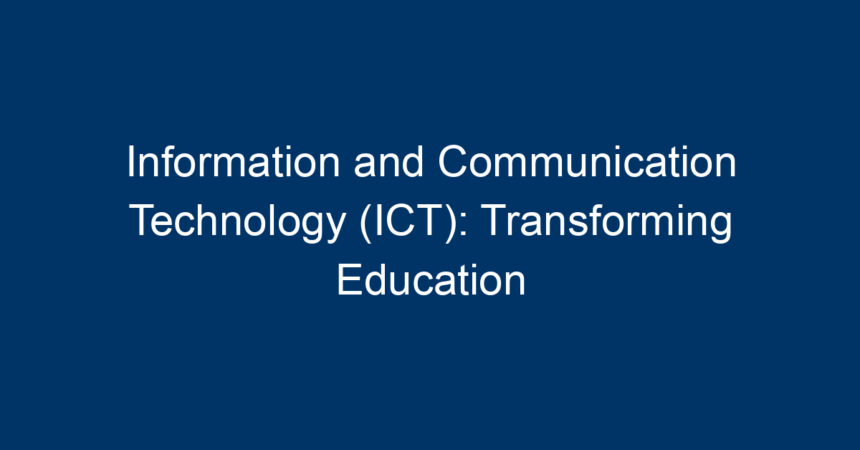In the rapidly evolving landscape of education, Information and Communication Technology (ICT) has emerged as a powerful catalyst for change. From online learning platforms to interactive teaching methods, ICT is reshaping how students learn, teachers instruct, and educational institutions operate. This article explores the significance of ICT in education, its various applications, the challenges it faces, and the future it holds for learners around the globe.
The Rise of ICT in Education
Understanding ICT
Information and Communication Technology (ICT) encompasses the tools and resources used to communicate, create, disseminate, store, and manage information digitally. In the educational context, ICT refers to various technologies, including computers, the internet, mobile devices, and digital tools like learning management systems (LMS).
The Need for Transformation
Traditional teaching methods are often criticized for being rote and stagnant. The increasing demand for personalized and skill-oriented learning experiences has highlighted the necessity for educators to adopt innovative approaches. ICT meets this demand by enabling diversified teaching methods and providing students with more engaging learning experiences.
Benefits of ICT in Education
Enhanced Learning Experience
One of the primary advantages of integrating ICT into education is the enhancement of the overall learning experience. With tools like multimedia presentations, simulations, and interactive games, students can grasp complex concepts more easily, making learning enjoyable and effective. Studies have shown that ICT can lead to higher student engagement, retention, and understanding.
Accessibility to Information
With the internet at their fingertips, students can access a vast array of information from anywhere in the world. This democratization of knowledge helps bridge gaps in education, allowing learners in remote areas to access high-quality resources and materials. Online databases, e-books, and academic journals have made research more accessible than ever.
Personalized Learning
ICT offers a unique opportunity for personalized learning experiences. Adaptive learning technologies can assess a student’s capabilities and tailor educational content to their specific needs. This ensures that every student can learn at their own pace, thereby reducing dropout rates and improving overall educational outcomes.
Collaboration and Communication
ICT facilitates collaboration and communication among students and educators in ways that traditional classrooms cannot. Tools like discussion forums, video conferencing, and collaborative platforms (e.g., Google Workspace) allow students to work together on projects remotely. This encourages teamwork, essential for today’s globalized job market.
Teacher Empowerment
For educators, ICT provides valuable resources for developing their professional skills. Online courses, webinars, and forums enable teachers to stay updated with the latest pedagogical methods and technologies. Furthermore, ICT tools can streamline administrative tasks, allowing educators to focus more on teaching.
Challenges of Implementing ICT in Education
Digital Divide
Despite the many advantages, the digital divide remains a significant challenge. Not all students have equal access to technology and high-speed internet. This inequality can exacerbate existing educational disparities, particularly in low-income communities. Addressing this issue requires a concerted effort from governments, educational institutions, and technology providers.
Resistance to Change
Change can be daunting for many educators accustomed to traditional teaching methods. Resistance to adopting ICT can hinder the integration of technology in education. Professional development programs are essential to help teachers become comfortable with new technologies, enabling them to utilize them effectively.
Cybersecurity Concerns
As educational institutions increasingly rely on digital tools, cybersecurity becomes a pressing concern. The risk of data breaches and cyberbullying can undermine the integrity of educational environments. Schools must invest in robust cybersecurity protocols to protect student data and promote a safe learning atmosphere.
The Future of ICT in Education
Blended Learning Models
The future of education is likely to embrace blended learning models, which combine traditional classroom experiences with online learning. This hybrid approach allows for greater flexibility and accommodates diverse learning styles. ITCs role in facilitating such models is critical, as it provides the necessary infrastructure and resources for seamless integration.
Artificial Intelligence (AI) in Education
The emergence of Artificial Intelligence (AI) in education is poised to revolutionize learning. AI-driven analytics can offer insights into student performance, helping educators identify students who need additional support. Virtual tutors and chatbots may also provide immediate assistance to learners, enhancing the learning experience.
Lifelong Learning
As industries evolve, the concept of lifelong learning is becoming increasingly vital. ICT empowers individuals to pursue education beyond traditional classroom settings, enabling continuous skill development. Online courses, webinars, and digital certifications from reputed institutions make it convenient for professionals to upgrade their skills at their own pace.
Actionable Insights for Educators and Institutions
-
Embrace Professional Development: Educators should engage in training programs that focus on ICT skills and digital literacy.
-
Promote Digital Equity: Institutions and policymakers must work together to provide equal access to technology for all students, particularly in marginalized communities.
-
Incorporate Student Feedback: Actively seek feedback from students on the ICT tools used in the classroom to ensure that their needs and preferences are being met.
-
Adopt a Gradual Implementation Strategy: Introduce ICT tools gradually, allowing both students and teachers to adjust and adapt to new technologies effectively.
-
Ensure Cybersecurity Measures: Implement strong cybersecurity protocols to protect the data and privacy of students.
-
Foster Collaboration: Encourage students to collaborate on projects using digital tools. This can enhance their teamwork skills and improve their ability to work in diverse settings.
- Stay Updated: Regularly update the curriculum to include the latest ICT tools and resources, ensuring students are prepared for modern workplace demands.
Conclusion
Information and Communication Technology (ICT) is undeniably transforming the landscape of education, offering students and educators unique opportunities to enhance learning experiences. While challenges remain, the potential benefits of ICT are vast and varied. By embracing technology, investing in teacher training, and promoting digital equity, educational institutions can create a more inclusive, engaging, and effective learning environment.
As we look to the future, leveraging the power of ICT can help prepare learners for the complexities of an ever-changing world. The integration of ICT in education is not just a trend; it is a necessity for fostering innovation and creating lifelong learners equipped with the skills to succeed in the 21st century.




